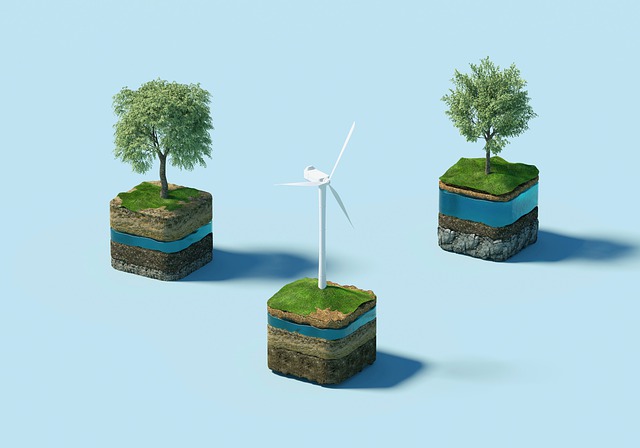In this article, you will learn about the concept of green streets and how they can benefit both the environment and the community. Green streets are an innovative approach to managing stormwater that involves incorporating vegetation, soil, and engineered systems. By doing so, they are able to slow down, filter, and cleanse stormwater runoff from impervious surfaces. Unlike traditional streets that direct stormwater runoff into storm sewer systems, green streets capture rainwater at its source. This not only protects water quality but also replenishes groundwater supplies. Additionally, green streets absorb carbon, improve air quality, and enhance the aesthetics of a neighborhood.
One of the key advantages of green streets is their ability to reduce peak stormwater flows. This means that they can help minimize the occurrence of flooding, thereby providing a more resilient and safer environment for the community. Furthermore, green streets eliminate the need for expensive underground systems and can help lower energy costs for the community. By increasing the infiltration and filtration of runoff, green streets also mitigate the negative impacts of stormwater and improve pedestrian and bicycle access. If you’re interested in green street design and implementation, there are resources available such as guides and handbooks from organizations like WERF and the City of Portland.
Green Streets: Sustainable Stormwater Management and Community Benefits
A green street is a stormwater management approach that incorporates vegetation, soil, and engineered systems to slow, filter, and cleanse stormwater runoff from impervious surfaces. Unlike traditional streets that direct stormwater runoff into storm sewer systems that discharge into surface waters, green streets capture rainwater at its source, leading to various environmental and community benefits.

What are Green Streets?
Definition of Green Streets
Green streets are designed to mimic natural hydrological processes, allowing rainwater to be absorbed by the ground rather than entering surface waters. By incorporating vegetation and permeable surfaces, green streets reduce the volume and velocity of stormwater runoff, helping to prevent flooding, protect water quality, and enhance overall community aesthetics.
Components of Green Streets
Green streets typically consist of several key components, including:
-
Permeable Pavement: The use of permeable pavement allows stormwater to infiltrate into the ground instead of running off into storm sewers. This type of pavement can be made from porous materials such as pervious concrete or permeable pavers.
-
Vegetation: Green streets incorporate vegetation, such as trees, shrubs, and grasses, to help absorb stormwater and reduce the amount of runoff. These plants also provide aesthetic value and contribute to improved air quality.
-
Bioretention Areas: Bioretention areas, also known as rain gardens, are designed to capture and filter stormwater runoff. They typically consist of a shallow depression filled with soil and vegetation that helps to remove pollutants and recharge groundwater.
-
Swales: Swales are shallow, vegetated channels that are designed to convey stormwater runoff. By incorporating vegetation, swales slow down the flow of water, allowing sediment and pollutants to settle out before the water enters a receiving water body.
-
Infiltration Basins: Infiltration basins are excavated areas filled with sand or gravel that allow stormwater to slowly infiltrate into the groundwater. These basins serve as storage areas for excess runoff during heavy rain events.
Benefits of Green Streets
Green streets provide numerous benefits for both the environment and the community. Some of the key benefits include:
Water Quality Protection
Green streets play a crucial role in protecting water quality. By capturing and filtering stormwater runoff, they help to remove pollutants such as sediment, oil, and heavy metals before they enter water bodies. This helps to prevent contamination and improve the overall health of aquatic ecosystems.
Groundwater Replenishment
One of the significant benefits of green streets is their ability to replenish groundwater supplies. By allowing stormwater to infiltrate into the ground, green streets help to recharge underground aquifers, ensuring a sustainable water supply for the community.
Carbon Absorption
Vegetation in green streets helps to absorb carbon dioxide, a greenhouse gas responsible for climate change. By incorporating trees and plants, green streets contribute to reducing carbon emissions and improving air quality.
Improved Air Quality
Green streets also have a positive impact on air quality. Vegetation helps to filter out pollutants and release oxygen, resulting in cleaner and healthier air for the community. This can have significant benefits, particularly in urban areas where air pollution is a major concern.
Enhanced Neighborhood Aesthetics
In addition to their environmental benefits, green streets enhance neighborhood aesthetics. Trees, plants, and green spaces create an inviting atmosphere, improving the overall appearance of the community and providing opportunities for recreation and relaxation.

Stormwater Management
Capture at the Source
One of the primary objectives of green streets is to capture stormwater runoff at its source. By incorporating permeable pavement, bioretention areas, swales, and infiltration basins, green streets allow rainwater to infiltrate into the ground, reducing the volume and velocity of runoff.
Comparison with Traditional Streets
Unlike traditional streets that direct stormwater runoff into storm sewer systems, green streets provide a more sustainable alternative. Traditional stormwater management methods often result in increased peak flows, leading to flooding and erosion in water bodies. Green streets, on the other hand, help to minimize these impacts by capturing and filtering stormwater before it reaches surface waters.
Reduction of Peak Stormwater Flows
Green streets help to reduce peak stormwater flows by retaining or infiltrating stormwater runoff. This reduces the overall volume of runoff that enters storm sewer systems, minimizing the risk of flooding during heavy rain events.
Elimination of Expensive Underground Systems
One of the significant benefits of green streets is their ability to eliminate the need for expensive underground stormwater management systems. Traditional stormwater management methods often require the construction and maintenance of extensive underground infrastructure. Green streets provide a cost-effective alternative by utilizing natural processes to manage stormwater.
Minimization of Energy Costs
Green streets also help to minimize energy costs associated with stormwater management. Traditional stormwater management methods often require significant energy inputs, such as pumping and treating water. Green streets, on the other hand, rely on natural processes, reducing energy consumption and associated costs.
Improving Runoff Infiltration and Filtration
Increase in Infiltration and Filtration
One of the primary objectives of green streets is to increase infiltration and filtration of stormwater runoff. By incorporating permeable pavement, bioretention areas, and infiltration basins, green streets allow rainwater to infiltrate into the ground, reducing the amount of runoff that enters surface waters.
Reduction of Flows
Green streets help to reduce the volume and velocity of stormwater flows. By slowing down the flow of water through swales and bioretention areas, green streets allow time for sediment and pollutants to settle out, improving the quality of runoff that enters water bodies.
Flooding Mitigation
Flooding is a significant concern in many communities, particularly during heavy rain events. Green streets help to mitigate flooding by capturing and storing excess stormwater runoff. By incorporating infiltration basins and bioretention areas, green streets provide additional storage capacity, reducing the risk of flooding.
Pedestrian Access Improvement
Green streets also have the potential to improve pedestrian access and safety. By incorporating trees, plants, and green spaces, green streets create a more inviting and enjoyable environment for pedestrians. This can help to encourage walking and cycling, promoting active transportation and reducing reliance on motor vehicles.
Bicycle Access Improvement
In addition to pedestrian access, green streets can also improve bicycle access. By creating dedicated bike lanes and incorporating bike-friendly infrastructure, green streets help to promote cycling as a sustainable mode of transportation.

Resources for Green Street Design
Several resources are available for green street design, providing guidance and best practices for implementation. Some of the key resources include:
WERF Guides and Handbooks
The Water Environment & Reuse Foundation (WERF) provides a range of guides and handbooks on green infrastructure and stormwater management. These resources offer valuable insights into the design, implementation, and maintenance of green streets.
City of Portland Guides and Handbooks
The City of Portland in Oregon has been at the forefront of green street design and implementation. The city has developed several guides and handbooks that provide comprehensive guidance on various aspects of green street design, including construction details, planting guidelines, and maintenance practices.
Other Available Resources
Numerous other resources are available from organizations and agencies dedicated to sustainable stormwater management. These resources offer valuable information on green infrastructure, including case studies, design guides, and best practices.
Challenges and Considerations
While green streets offer numerous benefits, there are challenges and considerations that need to be addressed during design and implementation. Some of the key challenges include:
Maintenance and Long-Term Sustainability
Green streets require regular maintenance to ensure their long-term sustainability. This includes monitoring vegetation health, cleaning and maintaining bioretention areas, and inspecting permeable pavements. Adequate funding and community involvement are essential for the successful maintenance of green streets.
Adaptation to Different Environments
Green street design needs to consider the unique characteristics and challenges of different environments. Factors such as climate, soil conditions, and available space can influence the effectiveness and viability of green streets. Designers need to adapt their approaches to ensure optimal performance in different regions.
Community Involvement and Education
Community involvement and education are crucial for the successful adoption of green streets. Building awareness and engaging with the community can help to address any concerns or misconceptions about green infrastructure. Education programs can also help to promote sustainable practices and ensure the long-term success of green streets.
Case Studies
Several case studies have demonstrated the successful implementation of green streets and the benefits they provide. Two notable examples include:
Successful Green Street Implementation in City X
In City X, green streets were implemented as part of a broader stormwater management plan. By incorporating permeable pavement, bioretention areas, and swales, the city was able to reduce peak stormwater flows and improve water quality. The green streets also enhanced the aesthetics of the community, providing recreational opportunities for residents.
Benefits and Lessons Learned in City Y
In City Y, the implementation of green streets resulted in several significant benefits. The green streets helped to reduce the risk of flooding and improved water quality in local water bodies. The city also observed increased pedestrian and bicycle access, promoting active transportation and improving community health. Lessons learned from the implementation process included the importance of community engagement and ongoing maintenance.
Impacts on Community Life
Green streets have a profound impact on community life, providing numerous social, economic, and environmental benefits. Some of the key impacts include:
Improved Health and Well-being
Green streets contribute to improved community health and well-being. The presence of vegetation and green spaces has been shown to reduce stress, promote physical activity, and improve mental health. The potential for increased walking and cycling also supports active lifestyles and reduces the risk of chronic diseases.
Increased Social Interaction
The presence of green streets can foster social interaction within communities. Green spaces provide opportunities for residents to gather, connect, and engage in recreational activities. This can strengthen community bonds, improve social cohesion, and enhance overall quality of life.
Community Pride
Green streets contribute to a sense of community pride and ownership. The presence of well-maintained green infrastructure enhances the aesthetics of neighborhoods, making them more attractive and desirable places to live. This can lead to increased community engagement and a greater sense of belonging.
Policy and Regulatory Support
For green streets to become more widespread, policy and regulatory support are essential. Government initiatives, incentives, and the role of planning and zoning departments all play a crucial role in promoting and facilitating the adoption of green streets.
Government Initiatives
Government initiatives can include funding programs, grants, and policies that encourage the implementation of green streets. By providing financial support and creating favorable regulatory environments, governments can help to overcome barriers and promote sustainable stormwater management practices.
Incentives for Green Street Adoption
Incentives, such as tax credits or rebates, can encourage property owners to incorporate green infrastructure into their developments. These incentives can help to offset the initial costs of implementation and maintenance, making green streets a more attractive option for property owners and developers.
Role of Planning and Zoning Departments
Planning and zoning departments play a crucial role in integrating green streets into community design and land-use planning. By incorporating green infrastructure requirements into zoning codes and development regulations, planning departments can ensure that green streets are integrated into new developments and infrastructure projects.
Conclusion
Green streets offer a sustainable approach to stormwater management with numerous environmental and community benefits. By capturing and filtering stormwater runoff, green streets protect water quality, replenish groundwater supplies, absorb carbon, and improve air quality. They also enhance neighborhood aesthetics and provide opportunities for increased pedestrian and bicycle access. Resources for green street design and implementation are readily available, and successful case studies demonstrate the effectiveness and benefits of green streets. However, challenges such as maintenance, adaptation to different environments, and community involvement need to be addressed to ensure the long-term success of green street initiatives. With policy and regulatory support, green streets have the potential to become a standard practice for stormwater management, creating healthier, more sustainable, and vibrant communities.



